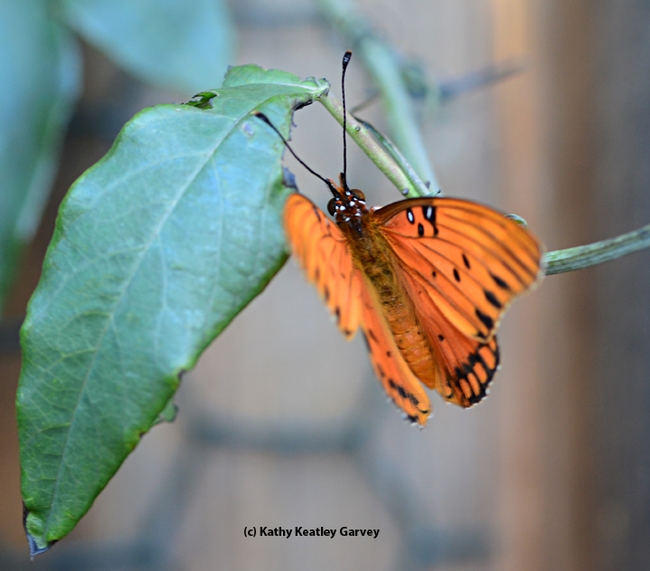It's rather troubling trying to rear subtropical butterflies, Gulf Fritillaries (Agraulis vanillae), in late autumn.
The string of warm sunny days in late November meant plenty of days for Gulf Frits to mate and reproduce. From eggs to larvae to chrysalids to adults--we watched the life cycle unfold on our passion flower vines (Passiflora).
Now it's freezing cold, with morning temperature dipping below 23 degrees.
No Gulf Frits flying outside.
But there is one Gulf Frit flying inside. It emerged from its chrysalis Friday. It is the sole occupant of our butterfly habitat.
"That butterfly could not have picked a worse time to come out," commented naturalist Greg Kareofelas, a Bohart Museum of Entomology volunteer who rears butterflies, including Gulf Frits.
He's so right. Freezing cold and pouring rain are not conducive to releasing butterflies back into the wild--the wild meaning the Passiflora.
On Sunday afternoon as the mercury rose a bit, I contemplated releasing my Gulf Frit. I asked Siri "How COLD is it in Vacaville, California?"
She answered "It is 49 degrees in Vacaville and I don't find that particularly cold."
What? So, now we're getting editorial comment when we ask a question about the weather?
Siri, as you know, is that "intelligent personal assistant and knowledge navigator" (thanks, Wikipedia) that responds to questions you ask on your iphone. Siri is Norwegian for "beautiful woman who leads you to victory."
Beautiful woman or not, Siri is neither leading ME to victory nor my boy butterfly.
Yes, my Gulf Frit is a male, according to butterfly expert Art Shapiro, distinguished professor of evolution and ecology at the University of California, Davis.
Like many other lepidopterists, Shapiro is concerned about the high pressure from the Arctic, resulting in freezing temperatures here. "The low temperatures we have experienced may be enough to extirpate the Gulf Fritillary butterfly regionally," he said. "This subtropical invader has become very popular with local residents (Yolo, Sacrameno and Solano counties, for instance), and if it is indeed wiped out, many will be sad to see it go."
Today Shapiro visited some of the warm pockets on the UC Davis campus but saw no "Leps" (Lepidoptera) of any kind.
There is, however, one restless male Lep in my butterfly habitat. His release date depends on the outside temperatures.
It does not depend on what Siri says.
Attached Images:

